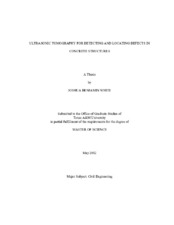| dc.description.abstract | This thesis evaluates a particular ultrasonic nondestructive testing (NDT) system in order to determine its capabilities and limitations in locating defects in concrete structures; specifically tunnel linings, bridge decks, and pavements. The device, a phased-array ultrasonic tomography (UST) system that utilizes shear waves, is a significant advancement in NDT systems. Consequently, there is a need in structural engineering to verify new technologies by assessing their flaw-detecting capabilities in a variety of structural applications.
The UST technique does not currently have a testing methodology that is field-ready. In order to develop a methodology, the system was evaluated based on its ability to detect simulated defects, then taken to the field to evaluate natural structural defects on public tunnels, pavements, and airport runways. Types of concrete defects the system is used to detect and localize include air- and water-filled voids, vertical cracks, horizontal delaminations, and abnormalities such as clay lumps. The device is also used to determine reinforcement depth and spacing as well as concrete thickness measurements.
This research concludes that the UST system is exceptional at locating horizontal delaminations ranging from 0.05-2.0 mm (0.002-0.079 in.), and is able to differentiate between fully debonded and partially-bonded areas. Vertical cracks could only be detected once they begin to form parallel to the testing surface; however, omission of surface details was found to be a strong indicator of crack presence. Backwall surfaces up to a depth of 762 mm (30 in.) were successfully and accurately determined. Air- and water-filled voids as well as reinforcement details such as layout and depth were also successfully determined and located. With the exception of some medium-sized clay lumps (with a diameter of approximately 102 mm, or 4 in.) surrounding reinforcement, all clay lumps tested were also highly successful. | en |


